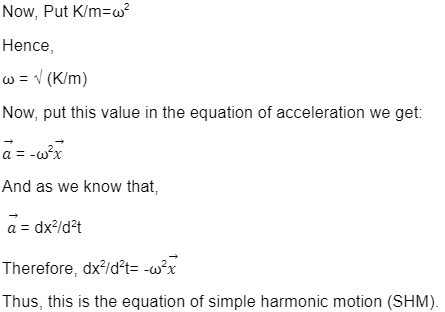Linear Simple Harmonic Motion is defined as the linear periodic motion of a body, in which the force of restoring (or acceleration) is always directed to the mean position and its magnitude is directly proportional to the displacement from the mean position.
A particle is said to perform linear simple harmonic motion when the particle undergoes oscillation about a point in stable equilibrium under a linear restoring force directed to the point and whose magnitude of the displacement of the particle from that point.
Simple Harmonic Motion
In simple harmonic motion, in physics, repetitive movements back and forth using an equilibrium, or central, position, so that the maximum displacement on one side of this position is equal to the maximum movement or displacement on the other side.
The duration or time interval of each complete vibration is the same. The force responsible for the motion is always directly proportional to distance from it. That is, F = −kx, Here, F is force, x is the displacement, and k is constant. This relationship is called Hooke’s law.
Types of Simple Harmonic Motion
There are two types of Simple harmonic Motion:
- Linear simple Harmonic motion
- Angular simple Harmonic Motion
Angular Simple Harmonic Motion
Angular SHM consists of “to and fro” angular oscillation of the body about a central position or orientation. The particle or body undergoes a slight angular shift or displacement about mean position.
This results in, when the body is under stable equilibrium is interrupted by a small external torque. Next, the rotating system produces a restoring torque, which tries to restore equilibrium.
Linear Simple Harmonic Motion
Linear simple harmonic motion is one of the simplest types of oscillatory motion, where a body, if displaced from its mean position, oscillates “back and forth” about the mean position and the restoring force is always towards its mean position and its magnitude is proportional to the displacement from mean position.
Terminology in Simple Harmonic Motion
Mean position
Generally the position at which the net or total force on the particle in SHM is zero is called the mean position.
Extreme Position
The Position which is located at a distance equal to the amplitude of the Simple Harmonic Motion (SHM) is termed as extreme position. Generally the velocity is zero at extreme position and acceleration is maximum.
Amplitude
Amplitude is defined as the maximum displacement from mean position is termed as amplitude.
Phase
Phase is defined for a simple harmonic motion as a quantity which lies inside the trigonometric function for the position of a particle. Phase defines the state that is the position and the direction of motion of Simple Harmonic Motion SHM.
Time Period
Time period is defined or expressed as the time interval after which the particle comes back in its initial phase is termed as time period.
Linear Frequency
Frequency is the Inverse of the time period.
Simple Harmonic Motion Formula
Let us take a particle having mass ‘m’ and moves in Simple Harmonic Motion along the path X’OX and let the mean position of particle be O. Let the speed of particle is when the particle is at p position.
Conclusion
In this article we are studying linear simple Harmonic Motion and its importance and its equation. A particle is said to perform linear simple harmonic motion when the particle undergoes oscillation about a point in stable equilibrium under a linear restoring force directed to the point and whose magnitude of the displacement of the particle from that point.
 Profile
Profile Settings
Settings Refer your friends
Refer your friends Sign out
Sign out








